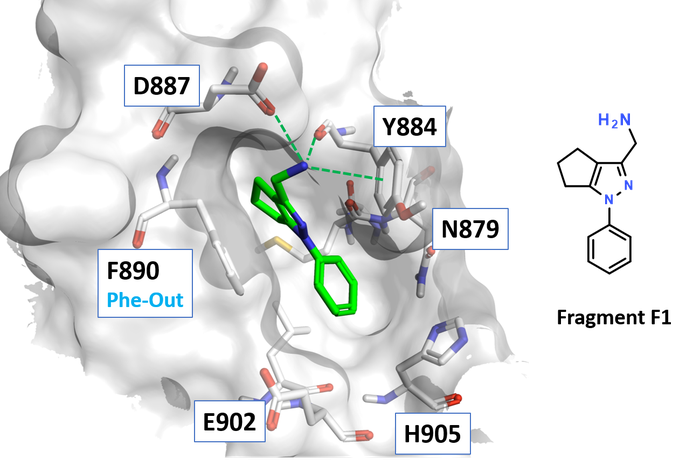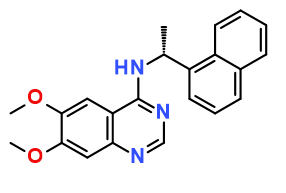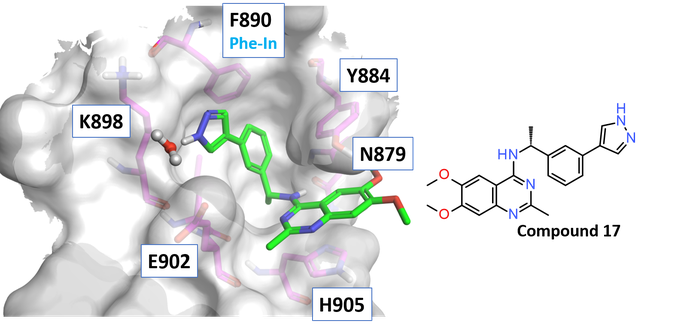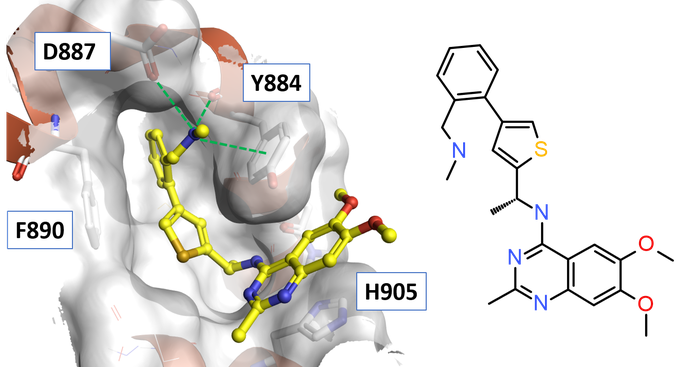Improving PROTAC properties via single-point changes to linkers
We explore how computational methods can be applied to proteolysis targeting chimera (PROTAC) design, to effectively tackle some of the ...
News
Bayer AG recently published an interesting paper on the discovery of potent and selective SOS1 inhibitors that block RAS activation via disruption of the RAS–SOS1 interaction.
They report using Spark™, Cresset’s bioisostere replacement tool, to rationally design linkers between active hit compounds from fragment screen and HTS. Herein, we review this interesting application of Spark to a ligand joining experiment that led to the discovery of BAY-293, a potent and selective inhibitor of KRAS-SOS1 interaction.
Bayer decided on a two-pronged approach, running a HTS campaign and a fragment screen in parallel. The fragment screen, with a library of 3,000 fragments, led to the identification of fragments which bind to and can induce a conformational change at the KRAS-SOS1 protein-protein interaction site. By triggering a rotation of the Phe890 side chain, they open a new subpocket adjacent to the main binding pocket.
F1 was chosen as the starting point for further optimization. The crystal structure of F1 in complex with SOS1 (PDB: 6EPM, Figure 1) shows that the phenyl moiety makes a π–π interaction with Phe890 (Phe-out). The aminomethyl moiety forms hydrogen bonds to Asp887 and the backbone carbonyl of Tyr884 and makes an additional cation–π interaction with the Tyr884 side chain.
 Figure 1. X-ray crystal structure of F1 complexed with KRASG12C–SOS1cat (PDB: 6EPM).
Figure 1. X-ray crystal structure of F1 complexed with KRASG12C–SOS1cat (PDB: 6EPM).
HTS of a Bayer library of 3 million compounds led to the identification of compound 1 (IC50 320 nM, Figure 2).
 Figure 2. Compound 1 (HTS hit: IC50 320 nM).
Figure 2. Compound 1 (HTS hit: IC50 320 nM).
Replacement of the naphthyl moiety in compound 1 with a pyrazolylphenyl group resulted in compound 17 (Figure 3), showing a good potency on SOS1 (IC50 140 nM) and improved aqueous solubility.
In terms of interactions with SOS1 (PDB: 5OVF, Figure 3), the quinazoline scaffold of compound 17 is sandwiched between His905 and Tyr884 (π–π stacking). The pyrazolylphenyl moiety occupies a hydrophobic pocket composed of Leu901 and Phe890 (Phe-in) and makes a T-stacking interaction with the side chain of Tyr884. The pyrazole moiety makes a water-bridged H-bond to Glu902. The central aniline NH makes a H-bond with the side chain of Asn879.
 Figure 3: X-ray crystal structure of compound 17 in the SOS1SB active site (PDB: 5OVF).
Figure 3: X-ray crystal structure of compound 17 in the SOS1SB active site (PDB: 5OVF).
As the fragment screen identified a new subpocket that was not yet addressed by the HTS hits, scientists at Bayer attempted a ligand joining approach using Spark to try and further improve potency by combining both ligand series. A superimposition of the crystal structures of compound 17 (PDB: 5OVF) and F1 (PDB: 6EPM), shown in Figure 4 – A, suggests that this approach is feasible.
After cutting out the overlapping aryl groups of compounds 17 and F1, the authors performed ligand joining experiments with Spark (Figure 4 – B, C) to identify appropriate linkers that could correctly orientate both the tetrahydrocyclopenta[c]pyrazole moiety of F1 and the aminoquinazoline group of 17 within the active site of SOS1. Among the top-scoring linkers suggested by Spark, the thiophene linker was chosen, synthesized, and found to be active.

Figure 4: Ligand-joining approach of fragment and HTS hits. A) Superimposition of the crystal structures of F1 bound to KRASG12C_SB–SOS1cat (SOS1 in gray, F1 and Phe890 with carbon atoms in magenta) and 17 bound to SOS1SB (17 and Phe890 shown; carbon atoms in green). B) Schematic depiction of the merging approach. C): Representation of F1 and 17 with respective fields from Cresset.
Optimization of the hybrid hits containing the thiophene linker identified by Spark by introducing polar moieties (such as OH, NH2) that mimic the hydrogen bond interactions of the amino side chain of F1, and trigger the Phe-out conformation, led to the discovery of the optimized compound 23 (BAY-293, IC50 21nM). As shown in Figure 5, the side chain amino group of compound 23 interacts with SOS1 by making H-bond interactions with Asp887 and Tyr884 backbone carbonyl, as well as a cation-π interaction with the Tyr884 side chain.

Figure 5. X-ray crystal structure of compound 23 in the SOS1 active site (PDB: 5OVI).
Further screening and antiproliferative data proved that compound 23 (BAY-293) is a potent and selective inhibitor of KRAS-SOS1 interaction and indicates that inhibition of GEFs may represent a viable approach for targeting RAS-driven tumors.
This paper by Bayer shows the utility of the Spark approach. As well as being a superb bioisostere finder, Spark’s advanced capabilities include easy-to-use methods for water replacement, macrocyclization, fragment growing and fragment linking. In this case Spark was vital in suggesting how to join two disparate molecules occupying different parts of a protein binding site, transferring SAR from one series to another.
Request a free evaluation of Spark to generate highly innovative ideas for your project.